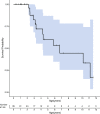A prospective natural history study of Krabbe disease in a patient cohort with onset between 6 months and 3 years of life
- PMID: 30089515
- PMCID: PMC6083585
- DOI: 10.1186/s13023-018-0872-9
A prospective natural history study of Krabbe disease in a patient cohort with onset between 6 months and 3 years of life
Abstract
Background: Krabbe disease is a rare neurodegenerative disorder caused by a deficiency in the lysosomal enzyme galactocerebrosidase. Patients with Krabbe disease present with a variable disease course depending on their age of onset. The purpose of this prospective cohort study was to characterize the natural progression of Krabbe disease in a large group of patients with disease onset between 6 and 36 months of life who were evaluated with a standardized protocol.
Methods: All patients with Krabbe disease who had onset between 6 and 36 months of age and were prospectively evaluated between 2000 to 2017 were included. Standardized neurodevelopmental, physical, and neurological examinations were performed. Other assessments included neuroradiologic and neurophysiologic tests, enzyme level, cerebrospinal fluid analysis, and GALC pathogenic variants when available. Descriptive statistics were used for analysis. Survival curve was estimated using the Kaplan-Meier method.
Results: Thirty-five patients (26 boys, 9 girls) with disease onset between 6 and 36 months of age were evaluated. Median age at symptom onset was 11.5 months, with a median delay of 3.5 months between onset of symptoms and diagnosis. Of the 32 symptomatic patients, 23 presented with initial signs or symptoms of disease between 6 and 12 months of life; nine presented after 12 months. The most common initial signs and symptoms were loss of acquired developmental milestones, irritability, abnormal gait, motor delay, and abnormal muscle tone. The most common magnetic resonance imaging abnormality was increased T2 signal in the periventricular white matter. Nerve conduction velocity results were abnormal for 21 of 24 patients. Patients with onset after 12 months had less peripheral nerve involvement and slower disease progression. Abnormal cerebrospinal fluid protein levels were obtained for 13 of 16 symptomatic children. Protein levels were normal in all asymptomatic children.
Conclusions: Based on our findings, we propose reclassifying the group of patients with onset ≤12 months as infantile and the > 12 month group as late-infantile. Patients with onset > 12 months are more likely to benefit from hematopoietic stem cell transplantation. The proposed change in classifications will allow physicians to improve their ability to recognize and diagnose patients and more precisely assess potential treatment effects after transplantation.
Keywords: Globoid cell leukodystrophy; Infantile; Krabbe disease; Late-infantile; Natural history; Newborn screening.
Conflict of interest statement
All patients and/or guardians provided written informed consent before entering into the study. All research was conducted with the approval of the institutional review boards (IRB) from the University of North Carolina (IRB-08-0237) and the University of Pittsburgh (IRB-PRO11050036).
All patients and/or guardians provided written informed consent for publication of individual data. Approval was granted by the institutional review boards (IRB) from the University of North Carolina (IRB-08-0237) and the University of Pittsburgh (IRB-PRO11050036).
There are no potential conflicts of interest among the authors.
Springer Nature remains neutral with regard to jurisdictional claims in published maps and institutional affiliations.
Figures






References
Publication types
MeSH terms
Grants and funding
LinkOut - more resources
Full Text Sources
Other Literature Sources
Medical

